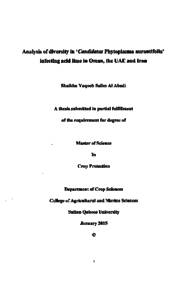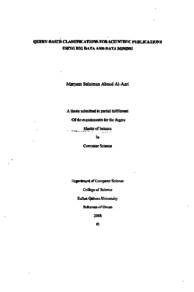Document
Analysis of diversity in 'Candidatus Phytoplasma aurantifolia infecting acid lime in Oman, the UAE and Iran.
Publisher
Sultan Qaboos University
Gregorian
2015
Language
English
English abstract
Witches' broom disease of lime (WBDL) is the most devastating disease of acid lime in Oman, UAE and Iran. The disease was reported in Oman in the 1970s, in the UAE in the 1980s and in Iran in the 1990s and it is caused by Candidatus Phytoplasma aurantifolia'. WBDL killed over one million lime trees in Oman, the UAE and Iran. Despite efforts to characterize the disease, no study attempted to characterize the relationship among 'Ca. P. aurantifolia' from the three countries. This study utilized sequences of the 16S rRNA, imp and sech genes to characterize 57 isolates collected from Oman (38), the UAE (9) and Iran (10). Phylogenetic analysis using the 16S rRNA gene separated all isolates into 4 clusters, with the first cluster consisting of 48 (84%) isolates from Oman, the UAE and Iran.
Analysis indicated that all isolates shared a high level of nucleotide similarity based on sequences of the 16S rRNA (>98.9%). The level of genetic divergence was low using 16S IRNA (0-0.045) sequences and it was found to be very low based on imp (0-0.18) and secA genes (0-0.026). Isolates collected from Musandam showed the highest level of diversity, followed by isolates from Iran and Al-Ain, UAE. Analysis of presence of phytoplasma in lime seedlings from nurseries showed that 90% of the seedlings were infected by phytoplasma. This study shows the presence of low level of diversity among phytoplasma VILA isolates from Oman, UAE and Iran. It also showed that seedlings from commercial nurseries in Oman can contribute to the movement of phytoplasma between geographical regions. The study discusses factors affecting diversity of phytoplasma and the potential ways for managing the disease.
Member of
Resource URL
Arabic abstract
مرض مكنسة الساحره (WBDL) هو المرض الأكثر تدميرا وإنتشارا في الليمون في سلطنة عمان والإمارات العربية المتحدة وإيران. تم تسجيل هذا المرض لأول مره في سلطنة عمان في بداية السبعينات من القرن الماضي، ثم في دولة الإمارات العربية المتحدة في 1989 و في إيران في نهاية التسعينات، حيث تعتبر الفايتوبلازما " Candidatus phytoplasma aurantifolia" المسبب الرئيسي للمرض. قتل المرض أكثر من مليون شجرة ليمون في سلطنة عمان والإمارات العربية المتحدة وإيران. ورغم الجهود المبذولة لتشخيص وتعريف هذا المرض الا أنه لا توجد دراسة التوصيف التنوع الجيني للفايتوبلازما في هذه الدول الثلاث. في هذه الدراسة تم إستخدام ثلاثة جينات لتوصيف التنوع الجيني لمسبب المرض وهذه الجينات هي 16S rRNA و imp و secd حيث تم توصيف 57 سلالة تم جمعها من عمان (38) والإمارات العربية المتحدة (9) وإيران (10). بعد تحليل النشوء والتطور باستخدام الجين 16S rRNA ظهرت 4 مجموعات في الشجرة الجينية، المجموعة الأولى اشتملت على 48 (784) سلالة من عمان والإمارات العربية المتحدة وإيران. أشار التحليل إلى وجود تشابه كبير على مستوى نوكليوتيدات جين 16S rRNA (> % 98 . 9 ). وكان مستوى الاختلاف الجيني منخفضا باستخدام 16S rRNA ( 0 . 045 - 0 ) وايضا كان الاختلاف منخفضا بشكل كبير على أساس جينات imp ( 0 . 018 - 0 ) و secA ( 0 . 026 - 0 ). أظهرت العينات التي تم تجميعها من مسندم (سلطنة عمان أعلى مستوى من التنوع، تليها العينات من إيران و العين بالإمارات العربيه المتحده. وأظهر تحلیل وجود الفايتوبلازما في شتلات الليمون العماني من المشاتل أن 90% من الشتلات أصيبت بالفايتوبلازما تبين هذه الدراسة وجود مستوى متدني من التنوع بين الفايتوبلازما من عمان والإمارات العربية المتحدة وإيران، كما تشير الدراسة إلى أن الشتلات يمكن أن تسهم في نقل الفايتوبلازما بين المناطق الجغرافية. تناقش الدراسة العوامل التي تؤثر على تنوع الفايتوبلازما وطرق إدارة المرض.
Category
Theses and Dissertations


